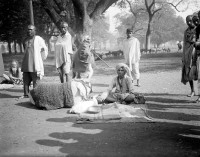 A heretofore unknown collection of 178 glass plate negatives taken in India during the heyday of the British Raj were found in a shoebox in the archives of the Royal Commission on the Ancient and Historical Monuments of Scotland (RCAHMS) in Edinburgh. The negatives were still in their original five-by-eight-inch plate boxes which were wrapped in pages from 1914 issues of the English-language Indian newspaper The Statesman and then placed gingerly in a box that once held a pair of grey, size 9 Peter Lord loafers.
A heretofore unknown collection of 178 glass plate negatives taken in India during the heyday of the British Raj were found in a shoebox in the archives of the Royal Commission on the Ancient and Historical Monuments of Scotland (RCAHMS) in Edinburgh. The negatives were still in their original five-by-eight-inch plate boxes which were wrapped in pages from 1914 issues of the English-language Indian newspaper The Statesman and then placed gingerly in a box that once held a pair of grey, size 9 Peter Lord loafers.
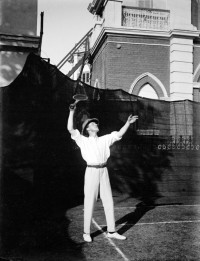 The pictures document daily life in India, mainly Calcutta (today known as Kolkata) in 1912. There are pilgrims at a religious festival, street fairs, riverside villages, portraits of nameless pith-helmeted British types, and spectacular night views of the city lights, among many other subjects. (Doesn’t the sporting gent at right look just like Tintin?) All of the images are in pristine condition. RCAHMS thinks the glass plates remained untouched since they were wrapped in 1914 newspaper (possibly in 1914), thus keeping the delicate negatives from degrading.
The pictures document daily life in India, mainly Calcutta (today known as Kolkata) in 1912. There are pilgrims at a religious festival, street fairs, riverside villages, portraits of nameless pith-helmeted British types, and spectacular night views of the city lights, among many other subjects. (Doesn’t the sporting gent at right look just like Tintin?) All of the images are in pristine condition. RCAHMS thinks the glass plates remained untouched since they were wrapped in 1914 newspaper (possibly in 1914), thus keeping the delicate negatives from degrading.
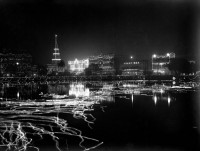 In December of 1911, King George V and Queen Mary traveled to India for the Delhi Durbar, an opulent ceremony proclaiming them Emperor and Empress of India. This was the only time a British monarch was actually present at Durbar, and the only time a British monarch visited India as her emperor. After the ceremony, they toured other cities of the subcontinent, including Calcutta right before and after the New Year.
In December of 1911, King George V and Queen Mary traveled to India for the Delhi Durbar, an opulent ceremony proclaiming them Emperor and Empress of India. This was the only time a British monarch was actually present at Durbar, and the only time a British monarch visited India as her emperor. After the ceremony, they toured other cities of the subcontinent, including Calcutta right before and after the New Year. 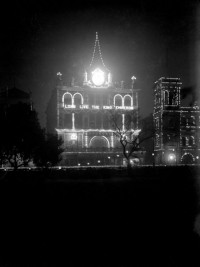 There are some amazing pictures in the collection showing the city decked out in welcome, documentation as historically significant as it is beautiful given that George V had unexpectedly announced at the Durbar that the capital of India would be moved from Calcutta to Delhi.
There are some amazing pictures in the collection showing the city decked out in welcome, documentation as historically significant as it is beautiful given that George V had unexpectedly announced at the Durbar that the capital of India would be moved from Calcutta to Delhi.
RCAHMS has no idea where the pictures came from or who the photographer was. They theorize that the pictures could have been taken by a British civil servant stationed in Calcutta, or by a Scotsman involved in the jute trade. In the early part of the 20th century, there was a thriving trade in raw Indian jute fibers between Calcutta and Dundee, Scotland. 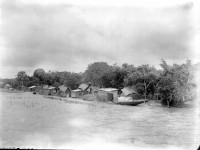 Factories owned by formidable local industrialists known as the Jute Barons spun the raw jute fibers into a plethora of consumer products like twine and burlap bags. There was enough of a Scottish community in Raj-era Calcutta that they had their own cemetery which has recently been restored and documented.
Factories owned by formidable local industrialists known as the Jute Barons spun the raw jute fibers into a plethora of consumer products like twine and burlap bags. There was enough of a Scottish community in Raj-era Calcutta that they had their own cemetery which has recently been restored and documented.
RCAHMS architectural historian Clare Sorensen said, “We don’t know for sure how the negatives came to be in our collection. We receive archive material from countless different sources, from architectural practices to generous donations from the public, and sometimes take large amounts of material in at once, and often documentation for historical deposits does not exist.
“Over time all this new material will be inspected and catalogued as part of our collection and then made available to the public. It’s fantastic that a small shoe-box contained such a treasure-trove of photographic imagery, but in some ways it’s not unsual [sic]. Our experience as an archive has shown us that some of the most interesting discoveries can be made in the most unlikely of places.”
The entire collection has been digitized and is very much worth a browse. They’ve also put a selection of 40 highlights in this gallery.
great find
BENJAMIN RAUCHER
Imagine their delight when rummaging through their old archive material and coming across a little treasure, previously unrecorded and currently unknown. I wonder what other treasures the Royal Commission on the Ancient and Historical Monuments of Scotland has.. and other major collections for that matter.
Just now I am particularly fascinated with images from India, during the 1890s-1930s. I wrote a post on pig-sticking and had some trouble finding professional photos. A couple of days after the blog was published, I found great photos in Africa Hunting.
many thanks
Hels
http://melbourneblogger.blogspot.com.au/2012/05/kadir-cup-champion-pig-stickers-in.html
It’s dizzying to think of all the gems hidden away in storage rooms all over the world. It makes me want to lock myself in an archive and never come out.
Your pig-sticking post is fascinating. When I was researching King George V’s trip to India, I found that he and his entourage popped over to Nepal after the Dehli Durbar to hunt game. The final tally of slaughter was shocking, like something from a Roman venatio. Those dudes sure did love killing animals.
Amazing find of my country….eager to see more
I have around 350 glass plate negative and from the same time days of the raj
All in India with the royal visitor as well would like to know more about them can any one help ? Thanks